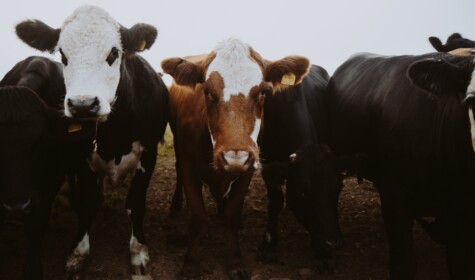Tuesday 30 August 2022
Mettrick’s abattoir [1] in the Derbyshire town of Glossop closes tomorrow after over 100 years, as detailed in a National Craft Butchers media release. This is causing heartache and distress for the 200 farmers who rely on it for slaughtering their animals.[2] But the closure will also spark wider anxiety amongst farmers who depend on a small abattoir in other regions.
Many farmers in agri-environment schemes, including those with organic, pasture-fed, rare breeds and other high welfare systems, have managed to survive financially by marketing the meat from their animals direct to consumers. For this to be possible there needs to be a small abattoir within a reasonable distance of the farm. [3].
As highlighted in the Sustainable Food Trust’s (SFT’s) 2018 report, ‘A Good Life and a Good Death’, the numbers of small abattoirs in the UK has declined dramatically in recent decades and continues to shrink by about 10% each year, with some areas already very poorly served. Small abattoirs are facing a wide range of challenges and extra costs. [4] Yet they are essential for economic and practical reasons to supply the greatly increased consumer demand for locally-produced meat. [5]
Richard Young, SFT policy director said, “This is an extremely worrying development. If a state-of-the-art small abattoir like this is unable to continue in business, yet more closures will follow. Countless meetings with Ministers and civil servants, an All-Party Parliamentary report, chaired by Lord Tree and the dedicated work of the Abattoir Sector Group, have not just come to nothing, the situation has actually got worse.”
“This isn’t about money, it’s about the Government being willing to set its own, risk-based rules for small abattoirs. Ironically, now we have left the EU, Ministers are more frightened to vary from the bureaucratic letter of EU regulations than when we had a voice in Europe.”
“All food, farming and rural organisations must work together to turn this situation round. It is in no one’s interest to let small abattoirs slip away like this. Even vegans should be working with us. I understand their concerns about animal slaughter, but I can’t believe any of them would want animals from smaller, higher welfare farms to travel further to abattoirs slaughtering hundreds, and in some cases, thousands of animals daily.”
ENDS
Notes for Editors
[1] The Glossop abattoir is run by brothers John and Steven Mettrick, the fifth generation since the business was founded. The Mettrick’s cutting and packaging facility will remain open, but local farmers wishing to continue using their services will incur the additional costs of longer journeys and transporting carcases from a larger abattoir to the Glossop facility.
[2] Many of the farms are in agri-environment schemes that require them to graze at low stocking density and not make hay until after ground-nesting birds have hatched and wildflowers set seed. Such farms have low profitability and being able to market meat themselves is make or break for the survival of many of them. The farms are spread over a large geographical area, but there are no other small abattoirs in the region with spare capacity. Small abattoirs are only permitted to slaughter 20 livestock units (LSUs) a week. One adult male bovine animal or 10 lambs equate to one LSU.
[3] Farmers retailing meat from their own animals, rarely need to slaughter more than one or two cattle or a few sheep or pigs in the same week. Most take the animals themselves in a livestock trailer, behind a 4-wheel drive vehicle. As a result, the transport cost per animal is very high if it is a long way from the farm to the abattoir. But the meat also has to be returned to the farmer, either butchered and packaged, or as carcases for butchering locally ready for retailing. This doubles the distance.
In contrast, most UK supermarkets have just one or two abattoirs that slaughter animals for them. As a result, many animals nationally have to travel considerable distances to slaughter. Although substantial improvements have been made in animal transport in recent decades, this still has both animal welfare and environmental costs. It is, however, cost-effective for the supermarkets, because large numbers of animals are transported together.
[4] Key factors behind the decline include: one-size fits all regulations which the Food Standards Agency acknowledges do not work for small abattoirs, over-burdensome paperwork, requiring additional staff; increased waste disposal costs and a chronic shortage of butchers and abattoir workers, made worse by low morale in the workforce and the impact of Brexit.
[5] Most large abattoirs will buy animals from any farmer to supply supermarkets and other major customers, but few of them are willing to slaughter animals for farmers who want to market the meat themselves and even where this is possible it still results in a major financial loss for the farmer. Because of the way large abattoirs are designed and run, they are unable to return the offal from individual animals to the farmers for retailing. For farmers, selling their meat on the basis of how the animal was fed, reared and slaughtered, this is disastrous. Offal from certified organic and pasture-fed animals is highly sought after by discerning consumers, and includes the oxtail, cheek, skirt, kidney, liver and suet.
Photo by Jason Taylor


